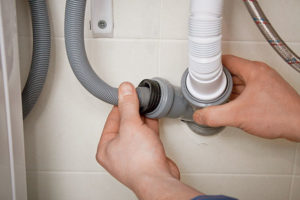 Diameter drain hose washing machine is important indicator for the performance of the entire drainage system. In most cases, it is supplied with the device, but the length shown is not always sufficient to ensure normal operation.
Diameter drain hose washing machine is important indicator for the performance of the entire drainage system. In most cases, it is supplied with the device, but the length shown is not always sufficient to ensure normal operation.
The functionality of the drain hose is affected by an incorrectly crimped compression sleeve, which can cause breaks. All this requires right choice hose and replacement. What diameter is optimal and how to install?
Types of hoses and their functional purpose
The diameter of the drain hose is an important attribute responsible for the drain system. Its main function is to remove contaminated liquid from the washing machine into the sewer.
There are the following types of hoses:
- standard;
- telescopic;
- hose in the bay;
- universal.
The standard type has a fixed length, it varies between 1-5 meters. If necessary, this parameter can be changed by connecting several pipes together.
The telescopic type is versatile. It is supplied in compressed form, the length of the pipe does not exceed 2 meters. Its main advantage is a diameter of 60 cm. However, due to its non-standard parameters, it is prone to frequent blockages. This is due to strong vibration during water supply.
The coiled hose is a convenient and practical module to use. It is equipped with special serifs that allow you to independently control its length. On average, one module is up to 55 cm. Pipe of this type high operational characteristics, however, it is not recommended to use it for the disposal of waste water. The risk of blockages remains high.
Drain pipes for household appliances, are generic attributes. They are based on durable polypropylene, which ensures maximum removal of contaminated liquid. At the ends of the universal hoses there are special fittings, the diameter of which varies between 19-22 cm. One end is connected to the washing machine, the other to the sewer.
Important: when choosing the optimal drainage system, it is necessary to take into account its functional purpose, the presence of disadvantages and advantages. Special attention given to length and diameter.
Optimal system parameters
You can buy a pipe designed to drain the liquid at any plumbing store. Before buying, you need to decide on the basic parameters and choose the optimal hose length. For this purpose, it is recommended to take an ordinary tape measure and estimate the distance from household appliances to the sewer pipe.
Attention: you need to measure with freedom, pulling a tape measure or rounding the distance down is not recommended. The hose should not be tightly connected, this will negatively affect the performance of the entire system.
In specialized stores, pipes are available in lengths from 1 to 5 meters. You can also choose a modern modular hose, it allows you to independently adjust the parameter. The improved pipe consists of a small bay, divided by 0.5 meters. The seller can rewind any declared length. If in doubt, it is advisable to purchase a hose with a margin and adjust the optimal setting at home.
For standard apartments, the best option is a pipe with a fixed length. It is easier to find it in the store, and in general for washing machine a fixed rate will suffice.
Important: don't try to acquire the maximum length attribute itself. This provokes the drain pump to work in an accelerated mode, which leads to its rapid deterioration. According to experts, the hose should not exceed more than 3.5 meters.
When the optimal length is chosen, it is necessary to move on to the rest of the indicators. An important attribute is a special type of connecting element that allows you to join the ends of the drain hoses. The connector is represented by a plastic tube, which is attached with clamps. They sell fasteners at auto parts stores. The standard clamp size is 16×27mm.
Attention: the ends of the drain pipe do not always differ in fixed parameters. Clamps must be selected according to the diameter drain system.
In most cases, the diameter of one end is 19 mm, the other - 22 mm. The thin end of the pipe is connected to the thick end of the extension. For maximum fixation, it is advisable to use connectors different diameters. With the same parameters, it is advisable to choose a connector 22×22mm.
For optimal elongation of the drain system, it is necessary to select the following parameters:
- extension hose;
- connecting element;
- collar;
- screwdriver.
For installation, pick up the clamps and put them on both ends of the pipe. Next, insert one end of the hose into the connector, and the other into the other end of the connector. All connections are fastened with clamps, using a screwdriver. The extension pipe must be connected to central sewerage. For check correct installation, start a test wash.
Normal operation is indicated by the absence of leaks and blockages during operation.
Installing the drain hose
Installation of the system is a responsible event, on the correctness of which the further functioning of household appliances depends. One end of the drain is mounted to the sewer in the bathroom. Experts recommend using a washbasin siphon as a drain. The best option is the purchase of a double siphon equipped with an additional outlet.
Important: Check the length of the hose before installation. If it is enough, start installation. Otherwise, carry out the extension process.
For lengthening, a plastic extension cord, a hose and a pair of clamps are suitable. The pipe coming out of household appliances is inserted into an extension cord of a wider diameter. The connection point is fixed with a clamp. An elongated pipe is connected to the sewer and the entire system is tested.
As statistics show, replacing the drain system is a responsible, but not complicated, procedure. This is due to the difficulty of choosing optimal parameters. And when performing a task of this kind, there is always a risk of doing something wrong. Finally, for some washing machines, the drain system is located in different parts device, which requires its complete analysis. This action greatly complicates the replacement procedure.
To determine the type of connection, the unit must be disassembled. In AEG, Siemens and Bosch system the drain is located under the front panel. In other designs, the location is standard - on back wall devices. You can find the hose at the bottom of the back cover of the case.
After removing the panel of the machine, you need to follow the given algorithm:
- unscrew the screws;
- remove the panel;
- smoothly remove the pump filter (it is recommended to prepare a container for draining liquid and rags in advance);
- remove excess water from the device;
- remove the snail;
- fix the fastening of the clamp by means of a photo;
- relax the clamp;
- disconnect the hose;
- remove the drain pipe;
- install an extension element;
- fix the connection point with a clamp;
- implement reverse process collection.
The algorithm of actions is not complicated, however, if you have any difficulties, it is advisable to seek help from specialists. This will avoid the development of force majeure situations in the future.
Attention: the machine without fail should be checked for functionality. In the event of leaks, it is advisable to evaluate the correct operation. If no deviations are found, and the problem remains unresolved, it is recommended to call the wizard.
Installing the inlet hose
The inlet hose is much more difficult to install. Before starting installation, it is advisable to choose the optimal length. According to experts, in total, the indicator should not go beyond 15 meters. This means that the maximum length of the filling pipe is 3 meters. Otherwise, an excessive load will be placed on the drain system, which will negatively affect the duration of its operation.
By standard, the thread of the fill pipe is ¾ inch, this is enough to connect to the stopcock. Inserting the eyeliner is a quick and easy process. In new houses with a modern overhaul, a place for installing a shut-off valve is prepared in the process of arranging the premises. This provides maximum convenience and comfort during installation.
With absence overhaul some difficulties are not excluded. In most cases, water pipes are not designed to install a stopcock. Installation is carried out in front of the faucet in the bathroom. In some cases, the hose is screwed onto the float valve drain tank. For this purpose, it is recommended to unscrew the flexible pipe intended for supplying water from the float valve. Then the winding is carried out on the inlet-faucet, and it is attached to it flexible pipe. It is advisable to use FUM tape for sealing.

If the inlet pipe is mounted to the mixer, it must be removed, and a tap for connecting to household appliances should be screwed onto the eccentric. Install the mixer itself on top of the fasteners. This installation method is not the best, but in some cases it is indispensable to use it.
On sale there are special taps designed for installation on float type valves and wall mixers. Drain and fill pipes are included. The main task of the inlet hose is to remove the processed liquid during washing. It is used if the length of the pipe is not enough. Inlet hoses are able to work under the pressure of water generated by the pump. Drain pipes function exclusively from natural pressure.
Important: what type of system is optimal, determines the location of the pipes in the apartment and the availability of specially designated places for installation.
When buying a machine, we almost always know its future location. But it often happens that due to size or for other reasons, the place changes. The first difficulty that SM owners face is the long distance from communications. Therefore, today we will talk about whether it is possible to extend the drain hose of an automatic washing machine, and how to do it correctly.
Before extending the hose, you must understand its parameters. Remember: in no case should you raise it higher than 1 meter in order to drainage pump could normally pump out the waste water from the tank. If you neglect this recommendation, the low power of the pump will not be enough to drain, the water will linger in the tank.
During connection, you must take care of the free tension of the tube, especially paying attention to the top point. It should be 60 cm higher than the lowest point. This is typical for all cars, regardless of brand and model. But still, if you have everything calculated up to a centimeter, you need additional information. To find out exact value, take a look at the user manual - everything is written there. If the manual says nothing, look for another technical documentation to SM.
Usually the maximum length of the hose does not exceed two meters, and more often it is only one and a half. If the tube is much shorter, or standard size it’s not enough for you, you can go for a trick - instead of lengthening the drain hose, get a new one of sufficient length.
Attention! You can purchase the item at a store specializing in the sale of plumbing, or at service center. If you did not find what you were looking for, go to "online" - find the desired part on the Internet.
To replace the part, you have to disassemble the case. If you are not ready for such a radical action, there is a simpler solution - connecting 2 washing machine hoses. To build a drain hose, take:
- Another new detail.
- Quality clamps.
- Connector for drain hoses.
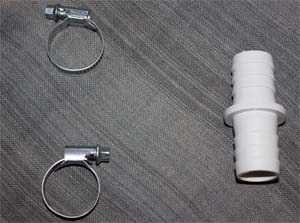
In principle, you can save on clamps if the connection is tight. But to make sure of this, you will have to visit the store repeatedly - first buy a connector, and then clamps, if there are doubts about the tightness. Also, clamps will come in handy without fail if you can’t pick up a connector.
If you bought a connector
- Fix the hoses in the connector on both sides.
- Secure with clamps.
- Install on the machine and sewer.
- Run a test wash, if everything is fine, the machine can be used.

Without connector
- Find a plastic or rubber tube. Its size should be such that it fits on both hoses.
- Buy clamps.
- The tube is put on the hoses so that they converge in the center. The tighter the tube sits, the better.
- Use clamps for a tighter fit.
If you are missing allowable length 3.5 meters, that is, there are other ways out of the situation:
- Install equipment closer to communications.
- Zoom in on the drain.
Want to visually see how to extend the drain hose? We offer video:
Having figured out how to lengthen the drain of the washing machine, you have solved only part of the problem. But you still need to figure out what to do with the water inlet hose, if its length is also not enough. About all this - below.
Not sure how to extend the inlet hose? Everything is extremely simple: instead of building up a water supply hose, buy a more authentic part. It is sold in the same place as the parts for the drain system. To change the part, disassembly of the SMA is not needed. Proceed like this:
- Disconnect the SM from the water supply, if it was connected to it.
- Unscrew the fasteners (manually, without tools, so as not to damage the plastic fasteners).
- Installing a new item. When tightening the fasteners, do not use tools - do everything manually.
- Open the valve and check the tightness of all connections.
- If everything is fine, proceed to washing. At least for testing.
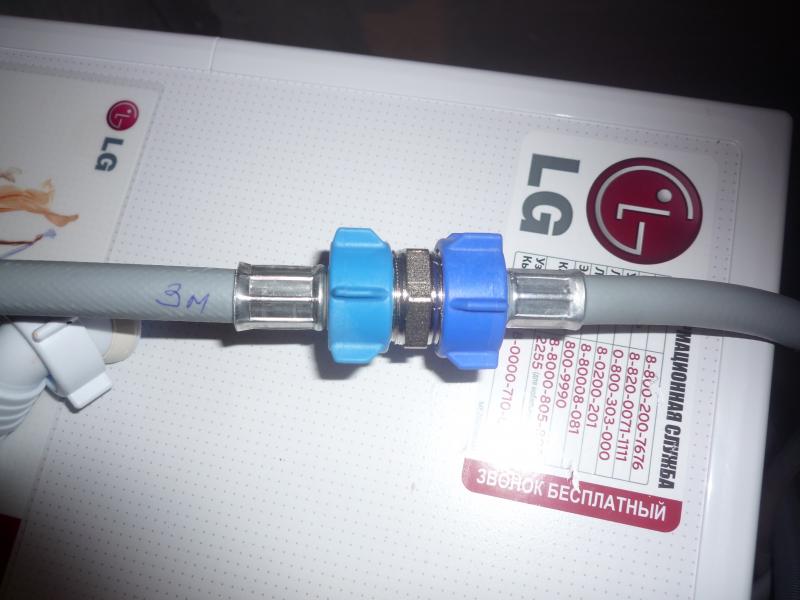 If you can’t find a hose of a suitable length, you can lengthen it. Usually the water supply hose is extended by the second of the same element, but you will need an adapter. Use a 3x4 inch brass nipple. To extend the water supply hose to washing machine, just screw the nipple onto each hose, and that's it - the job is done successfully.
If you can’t find a hose of a suitable length, you can lengthen it. Usually the water supply hose is extended by the second of the same element, but you will need an adapter. Use a 3x4 inch brass nipple. To extend the water supply hose to washing machine, just screw the nipple onto each hose, and that's it - the job is done successfully.
If you had to add or change parts, do not forget to check if your typewriter has enough cord to connect to the mains. If the cord is too short, or vice versa - the outlet is far away, then you need to pay attention to this moment. It is better not to use extension cords to connect the washing machine to the mains. This is fraught with serious damage: such extension filters often provoke a fire. 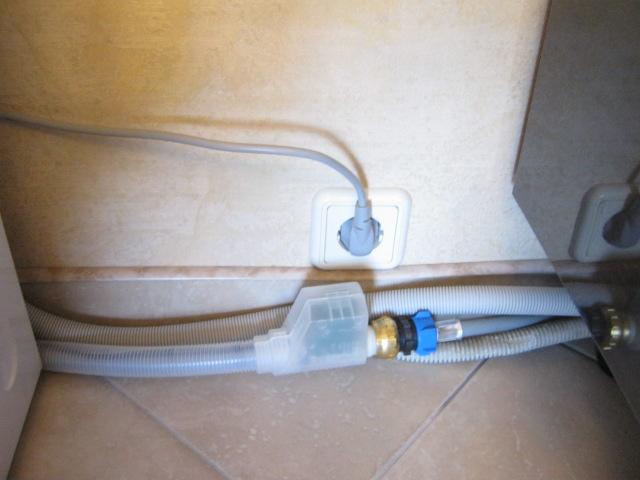
Now you know how the drain and intake hose of the washing machine is extended. And wherever your washing machine is, you will always find a way to successfully connect it to all communications.
To connect the washing (dishwasher) machine to the water supply and sewerage systems, special hoses are used. The hose for the washing machine can be installed independently. The main thing is to choose the right device so that it lasts a long time.
Inlet hose
The water supply hose connects the washing machine with and serves to fill household appliances with the necessary liquid.
Kinds
Inlet hose may be of the following form:
- rubber water hose;

- reinforced (standard rubber hose is protected by an additional layer, which gives it additional strength). Metal, nylon are used to reinforce the rubber hose;

- rubber hose for water supply with Aquastop system. An additional tube is located in the main hose. When a hose breaks inner space filled with water, which activates the mechanism automatic shutdown water supply.
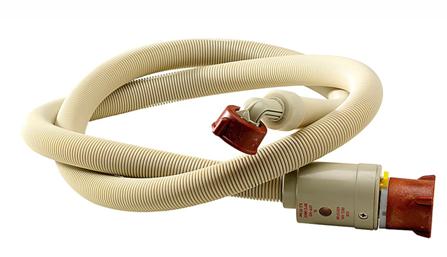
Inlet hoses differ in service life and cost of products. The cheapest and most short-lived is a regular rubber hose. The most expensive is a hose with a leak protection system.
Selection rules
How to choose a hose for connecting water supply? When choosing, it is recommended to pay attention to the following factors:
- operating pressure that the hose can withstand. For apartment buildings suitable products designed for 20 bar. For private homes, this parameter is recommended to be increased by 5-10%;
- Maximum temperature. It is advisable to select hoses designed for temperatures of 90 degrees or more. Standard hoses are available with a margin of safety and are able to withstand temperatures of 100ºС;
- hose length. When determining the parameter, it is important to consider the distance between household appliances and water pipe. The hose must not be connected with tension or excessive kinks. Tension or kinks will reduce the life of the product.
Wiring diagram
How to connect a hose to a washing machine? It is necessary to act according to the following scheme:
- incision is made in water pipe. A tee and a separate valve are installed at the tie-in site for local shut-off of the water supply;
- a straight end is connected to the tee faucet. The union nut mounted on the hose is equipped with rubber gasket, but for additional sealing threaded connection you can use FUM tape;

At the junction of the inlet hose with the water pipe, experts recommend installing an additional filter that will protect household appliances from small particles of debris contained in the water.
- the bent end of the hose is connected to the corresponding inlet of the washing machine. Upon purchase, the hose hole is protected by a plug, which is removed immediately before installation;
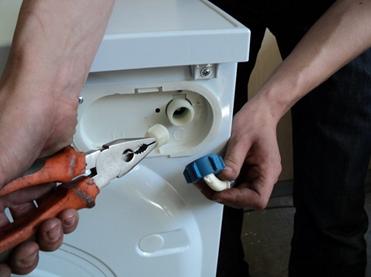
- the performance and tightness of the filling system of household appliances is checked.
Drain hose
The drain hose is designed to drain waste water from the washing machine.
Hose types
The washing machine drain hose is made of polypropylene. Fittings for connecting the device are located at the ends of the hose.
Available in stores the following types hoses:
- standard hose of a certain length. Manufacturers produce hoses from 1 m to 5 m long;
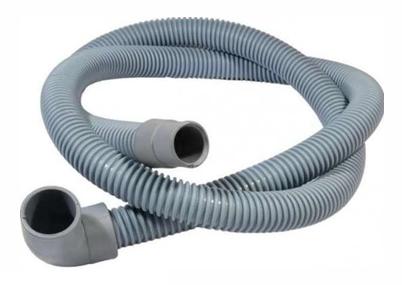
- telescopic hose. Corrugated hose can be stretched to the desired length. This eliminates the possibility of the formation of unnecessary kinks. The main disadvantage of a telescopic hose is its susceptibility to blockages, since the inner surface of the hose is also corrugated.

Drain hose connection diagram
Connect the drain hose for dishwasher(washing machine) directly to household appliances is quite simple. It is necessary to fix the end of the hose to the pump that pumps out water.

In most cases, you will need to remove the rear cover of the machine to replace the hose.
Difficulties among users are caused by the arrangement of drains from household appliances. Drainage of water can be carried out:
- in a sanitary ware located near household appliances, for example, in a bath. To do this, you must additionally purchase a holder for the drain hose, which will fix the hose in a certain position;

- into a siphon connected to plumbing. To equip the drain, you will need a siphon with an additional compartment and a holder. At the junction of the hose and siphon, a rubber cuff;

- directly in . To equip the drain into the sewer, you will need to organize a special outlet, which is carried out by inserting a tee and a rubber cuff that makes the joint tight.

If the length of the drain hose is not enough to connect household appliances, then the parameter can be increased. How to extend the hose? For this, a special adapter is used that connects two hoses into one system. The adapter is fixed using crimp clamps.

Extension of the hose without the use of adapters is prohibited, since it is impossible to achieve complete tightness of such a connection.
All stages of installation and connection of the washing machine are presented in the video.
By following these simple rules, you can select and replace the drain and inlet hose on your own.
Inlet hose- a product that is responsible for filling the washing machine with water. The water supply hose differs from the drain branch in that it is manufactured to a unique reinforced technology PVC, not plastic. The design of the inlet hose for the washing machine consists of steel wire or synthetic thread, which makes it very durable and can withstand the flow of water under pressure. Manufacturers in the manufacture of hoses for washing machines can use different materials, but the technology and design remains unchanged.
The inlet hose is sold complete with a washing machine, but sometimes it happens that it wears out before the washing machine itself. The article will discuss what the specifics of the duct for filling water and its connection are, what to do if the inlet hose starts to flow, and how you can lengthen the inlet hose yourself.
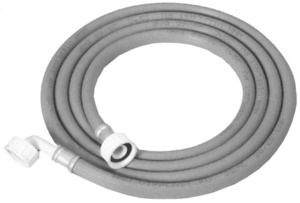 The washing machine hose is tubing with plastic nuts and fittings and has a marking that contains information about the working pressure and temperature. One part of it is connected to the water supply, and the second directly to the washing machine itself. Conscientious manufacturers install pressed metal sleeves at the junction of the fitting with the pipe.
The washing machine hose is tubing with plastic nuts and fittings and has a marking that contains information about the working pressure and temperature. One part of it is connected to the water supply, and the second directly to the washing machine itself. Conscientious manufacturers install pressed metal sleeves at the junction of the fitting with the pipe.
The channels for pouring water into the washing machine are:
- fixed length, which is from 1 to 5 meters;
- in a bay up to 10 meters long;
- telescopic, increasing in length, with a built-in Aquastop system, which can protect the bathroom from the flood.
Recognized as the best of its kind inlet hose with Aquastop system, as it can withstand water pressure at a bay of 70 and thanks to its unique system blocking the water supply, in case of rupture of the duct.
It should be noted that the length of the filling branch should not exceed 3 meters. It is possible to connect the filling channel in front of the mixer or install it by screwing it onto the float valve of the toilet flush tank. For these two options, special accessories can be found in the plumbing departments that simplify the connection of the washing machine inlet hose.
What to do if a leak is found?
There are several reasons why the inlet hose may be leaking:
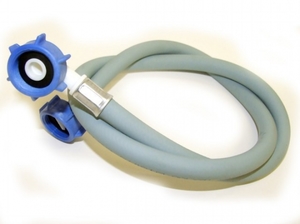
How to lengthen the water inlet hose of a washing machine
If it is not possible to produce replacement of the old inlet hose supply water to a new, but longer one, then there is a fairly simple and very economical method of lengthening it. To do this, you need an additional hose and a three-quarter inch brass nipple. The brass nipple is a metal connecting tube with a thread. First you need to disconnect the inlet hose from the washing machine. Next, you should combine the two extension ducts with a nipple, which, in turn, will act as a connector.
The role of the nozzle in the washing machine
The pipe, like any other part in the washing machine, plays an important role in its normal functioning. Thanks to the filler pipe, water and products enter the machine household chemicals for washing. The machine has drain pipe responsible for draining the water. In cases with newer models, additional nozzles are installed that are designed to remove foam and steam. In order for the washing machine to work without interruption, each pipe must be installed correctly and securely.
Sometimes the reason for the breakdown of the washing machine is the breakdown of the pipe, which is eliminated by replacing it. But in order to increase the time of its functioning, one should apply preventive measures. The nozzles should be cleaned periodically, just like a garbage filter, since from prolonged use, plaque can form inside it.
Repair and cleaning of the filler pipe of the washing machine
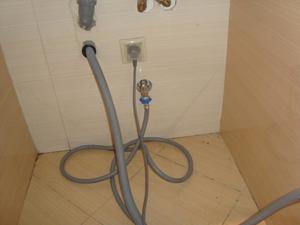 The branch pipe is located directly under the body of the washing machine, so it must first be disassembled. There must be a certain sequence.
The branch pipe is located directly under the body of the washing machine, so it must first be disassembled. There must be a certain sequence.
First you need to make sure that the flow of water into the machine is blocked. Next, the washing machine should be disconnected from electricity. The compartment for receiving the powder is removed. The trash filter is removed. Place the washing machine on a prepared blanket or cloth on a free area of the floor. The machine should be carefully placed on the side wall.
If there is water in the machine, it should be removed. Failure to do so may damage the control module of the washing machine. Next, remove with a screwdriver top cover cars can be seen on the left upper corner rubber tube, which comes from the gulf of water. With pliers, carefully, trying not to damage them, since they will be fastened back, you should unclench and move the clamps that hold it to the middle of the pipe. Next, remove the filler pipe. By removing the pipe, you can determine its condition. If there are blockages, they must be removed; if damage is observed, a new suitable nozzle should be purchased.
The quality of washing directly depends on the components of the washing machine and proper care for them. If, due to a breakdown, it was necessary to replace or repair any parts, you should seriously approach the solution of the problems that have arisen, and in the case of buying new components, do not be stingy and opt for better materials.
Attention, only TODAY!
Your home appliances will work flawlessly if they are properly installed, so we will tell you how independent connection washing machine. All installation operations of the machine can be divided into three groups:
- connection to the sewerage;
- leading to plumbing system;
- connection to electrical network.
The ability to independently install the "washer" will save time and money
Connection to the sewer system
Although it seems simple to connect a washing machine to a sewer system by yourself, in reality it is a complex process. Connecting the washing machine to the sewer can be done in different ways:
- temporary scheme;
- fixed connection.
For the first way the instruction is simple:
- connect the outlet pipe to the drain hose;
- fix the latter on the sides of the bathroom (or toilet bowl, washbasin).
![]()
In the second case everything is much more complicated. When connecting the machine according to a stationary scheme on your own, be sure to consider the following rules:
- The length of the drain hose may vary, but its maximum value must remain within acceptable limits. These data, as a rule, are indicated by the manufacturer in the instructions for the product. The longer the hose, the greater the load on the pump, which can disable it ahead of time.
- The drain connection involves the use of sewer siphons with check valve, the design of which does not allow drains to enter the equipment and unpleasant odors from the sewer. You can also bend the hose so that it forms air gap between sewer pipe and drain hose. In this case, the distance from the floor to the bending point of the hose must be at least 50 cm.
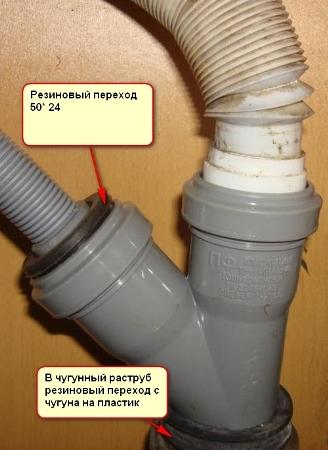
Pro tip: Increasing the length of the drain hose is sometimes essential, but remember that it depends on the capacity of the drain pump. Therefore, manufacturers prescribe in the instruction manual this characteristic – maximum length hose.
On the one hand, the drain hose is connected to the rear wall of the machine (at a height of about 80 cm), and on the other hand, it is connected to sewer network in the bathroom or in the kitchen through a special siphon or with a hose bend. Some experts recommend using a loose connection.
An air gap at the junction is needed so that during washing, water is not sucked into sewer system because it causes the washing machine to malfunction. The height at which the gap will be located must be greater than the level of water rise in case of clogging of the sewer, otherwise the probability of flooding the apartment due to the low-placed gap increases.

Connecting the washing machine to the water supply
Connection with a tie-in to the pipeline
Any washing machine is equipped with a special flexible hose(connection diameter - ¾ inch), through which the washing machine is connected to the water supply. If necessary, the length of the hose can be increased by sealing the joints with a rubber gasket. For this connection you need:
- Insert in cold pipeline. With an insufficient level of experience, this may necessitate the services of a plumber. In addition, it will be necessary to turn off the water in the entire riser. However, this is the most reliable method.
- Ideally, after the end of the operation of the machine, the water supply from the water supply should be shut off. For this purpose, a valve is installed on the water pipe, which turns to the “closed” position at the end of the wash.
- The correct connection diagram of the washing machine provides for the installation of a protective filter with a mechanical principle of operation, located after the valve. It prevents clogging of household appliances with suspended particles that appear in cold water after repair and preventive measures on the water supply system. This filter is a mesh and is subject to periodic cleaning from dirt.

Drain tap connection
It is also known to connect the washing machine to the water supply in another way - by connecting the supply hose to drain tap bathroom or sink. In this case, a longer inlet hose will be required, one end of which will be screwed to the tap after the gander is disconnected. Consumers using this scheme bringing household appliances to water, they claim that it takes less than a minute, but they are sure that there are no water leaks during the idle time of the machine, because the supply hose is not permanently connected to the water supply.
Pro tip: Many modern units are equipped with an Aqua-stop system that blocks the flow tap water to a disabled machine. For such equipment, the inlet hose has a block of electromagnetic valves at the end. They are connected to the machine by wires that control. The whole system is wrapped in a flexible casing. When the machine is turned off, the valve blocks the further flow of water into the device.
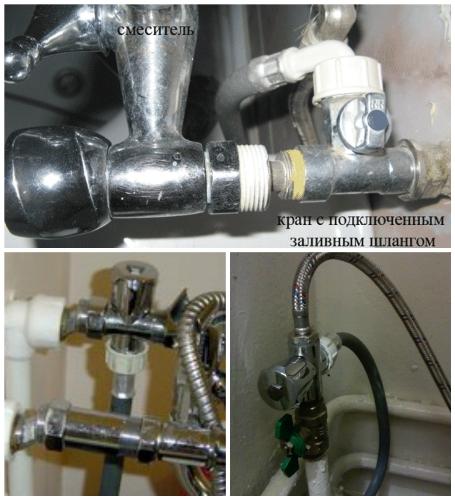
Connecting the washing machine to the mains
The most important condition for the operation of a washing machine is its safety during operation. And the correct connection of the washing machine to the mains is the most important point that ensures this. You must strictly follow the rules:
- A three-wire electrical socket must be installed at the installation site of the machine.
- In the switchboard, zero and ground busbars are installed for this.
- The ground wire must be securely insulated.
- If the power cord of the washing machine is not long enough to connect to the mains, use an extension cord with grounding.
- Never connect the ground cable to radiators or water and gas pipeline systems - it is life threatening!

Pro tip: When laying a grounding electric cable to power the washing machine, use wires with a cross section of 3 mm or more.
In houses with gas stoves often there are sockets for electric stoves that are not used as unnecessary. They are suitable for connecting washing machines because they already have an earth connection. If you have just such a case, just replace the socket designed for electric stove, to a typical grounded socket and feel free to connect the machine to it.
The optimal scheme for connecting the washing machine to the electrical network is the presence of a separate three-wire outlet, drawn from the shield. In this case, the cable can be placed inside the wall (by chasing) or externally pulled using plastic cable channel. The electric meter must have a rated current of 15 ÷ 30 A, and it is recommended to install an individual automatic machine on the connected cable.
![]()
If you don't have special training, and you are not sure that you will supply electricity with your own hands, it is better to invite electricians serving your home. They will qualitatively and in compliance with safety rules perform electrical wiring that feeds all powerful Appliances. But get ready for the fact that such work will bring a lot of trouble and will not be fast.
An alternative to a 3-wire power supply is a 2-wire cable equipped with a portable device that is controlled by residual current and shuts down the system in the event of a power outage.
As you can see, connecting a washing machine on your own is possible, you just need to have patience and a desire to extend the life of household appliances by performing a qualified installation.
Related videos
The video on connecting the washing machine below will help you get acquainted with the technology more clearly.


















